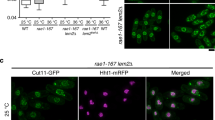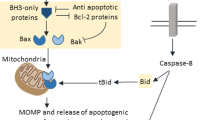Abstract
Although the interphase nuclear envelope is continuous with the endoplasmic reticulum, it is distinct from the endoplasmic reticulum in both form and composition. In metazoans, the nuclear envelope breaks down during mitosis and is thought to be completely reabsorbed by the endoplasmic reticulum. How these near neighbours are sorted out at the end of mitosis is an interesting mystery.
This is a preview of subscription content, access via your institution
Access options
Subscribe to this journal
Receive 12 print issues and online access
$189.00 per year
only $15.75 per issue
Buy this article
- Purchase on Springer Link
- Instant access to full article PDF
Prices may be subject to local taxes which are calculated during checkout




Similar content being viewed by others
References
Foisner, R. Inner nuclear membrane proteins and the nuclear lamina. J. Cell Sci. 114, 3791–3792 (2001).
Holmer, L. & Worman, H. J. Inner nuclear membrane proteins: functions and targeting. Cell. Mol. Life Sci. 58, 1741–1747 (2001).
Daigle, N. et al. Nuclear pore complexes form immobile networks and have a very low turnover in live mammalian cells. J. Cell Biol. 154, 71–84 (2001).
Yang, L., Guan, T. & Gerace, L. Integral membrane proteins of the nuclear envelope are dispersed throughout the endoplasmic reticulum during mitosis. J. Cell Biol. 137, 1199–1210 (1997).
Ellenberg, J. et al. Nuclear membrane dynamics and reassembly in living cells: targeting of an inner nuclear membrane protein in interphase and mitosis. J. Cell Biol. 138, 1193–1206 (1997).
Voeltz, G. K., Rolls, M. M. & Rapoport, T. A. Structural organization of the endoplasmic reticulum. EMBO Rep. 3, 944–950 (2002).
Pfeffer, S. Membrane domains in the secretory and endocytic pathways. Cell 112, 507–517 (2003).
Macaulay, C. & Forbes, D. J. Assembly of the nuclear pore: biochemically distinct steps revealed with NEM, GTPγS, and BAPTA. J. Cell Biol. 132, 5–20 (1996).
Harel, A. et al. Removal of a single pore subcomplex results in vertebrate nuclei devoid of nuclear pores. Mol. Cell 11, 853–864 (2003).
Walther, T. C. et al. The conserved Nup107–160 complex is critical for nuclear pore complex assembly. Cell 113, 195–206 (2003).
Soullam, B. & Worman, H. J. The amino-terminal domain of the lamin B receptor is a nuclear envelope targeting signal. J. Cell Biol. 120, 1093–1100 (1993).
Zhang, Q. et al. Nesprins: a novel family of spectrin-repeat containing proteins that localize to the nuclear membrane in multiple tissues. J. Cell Sci. 114, 4485–4498 (2001).
Mislow, J. M. K., Kim, M. S., Davis, D. B. & McNally, E. M. Myne-1, a spectrin repeat transmembrane protein of the myocyte inner nuclear membrane, associates with lamin-A/C. J. Cell Sci. 115, 61–70 (2002).
Foisner, R. & Gerace, L. Integral membrane proteins of the nuclear envelope interact with lamins and chromosomes, and binding is modulated by mitotic phosphorylation. Cell 73, 1267–1279 (1993).
Belgareh, N. et al. An evolutionarily conserved NPC subcomplex, which redistributes in part to kinetochores in mammalian cells. J. Cell Biol. 154, 1147–1160 (2001).
Pyrpasopoulou, A., Meier, J., Maison, C., Simos, G. & Georgatos, S. D. The lamin B receptor (LBR) provides essential chromatin docking sites at the nuclear envelope. EMBO J. 15, 7108–7119 (1996).
Segura-Totten, M., Kowalski, A. K., Craigie, R. & Wilson, K. L. Barrier-to-autointegration factor: major roles in chromatin decondensation and nuclear assembly. J. Cell Biol. 158, 475–485 (2002).
Newport, J. W., Wilson, K. L. & Dunphy, W. G. A lamin-independent pathway for nuclear envelope assembly. J. Cell Biol. 111, 2247–2259 (1990).
Liu, J. et al. Essential roles for Caenorhabditis elegans lamin gene in nuclear organization, cell cycle progression, and spatial organization of nuclear pore complexes. Mol. Biol. Cell 11, 3937–3947 (2000).
Moir, R. D., Yoon, M., Khuon, S. & Goldman, R. D. Nuclear lamins A and B1: different pathways of assembly during nuclear envelope formation in living cells. J. Cell Biol. 151, 1155–1168 (2000).
Vigers, G. P. & Lohka, J. J. A distinct vesicle population targets membranes and pore complexes to the nuclear envelope in Xenopus eggs. J. Cell Biol. 112, 545–556 (1991).
Drummond, S. et al. Temporal differences in the appearance of NEP-B78 and an LBR-like protein during Xenopus nuclear envelope reassembly reflect the ordered recruitment of functionally discrete vesicle types. J. Cell Biol. 144, 225–240 (1999).
Collas, P. & Courvalin, J. C. Sorting nuclear membrane proteins at mitosis. Trends Cell Biol. 10, 5–8 (2000).
Wiese, C., Goldberg, M. W., Allen, T. D. & Wilson, K. L. Nuclear envelope assembly in Xenopus extracts visualized by scanning EM reveals a transport-dependent “envelope smoothing” event. J. Cell Sci. 110, 1489–1502 (1997).
Hetzer, M. et al. Distinct AAA-ATPase p97 complexes function in discrete steps of nuclear assembly. Nature Cell Biol. 3, 1086–1091 (2001).
Hetzer, M., Bilbao-Cortés, D., Walther, T. C., Gruss, O. J. & Mattaj, I. W. GTP hydrolysis by Ran is required for nuclear envelope assembly. Mol. Cell 5, 1013–1024 (2000).
Zhang, C. & Clarke, P. R. Chromatin-independent nuclear envelope assembly induced by Ran GTPase in Xenopus egg extracts. Science 288, 1429–1432 (2000).
Walther, T. C. et al. RanGTP mediates nuclear pore complex assembly. Nature 424, 689–694 (2003).
Hetzer, M., Gruss, O. J. & Mattaj, I. W. The Ran GTPase as a marker of chromosome position in spindle formation and nuclear envelope assembly. Nature Cell Biol. 4, 177–184 (2002).
Simons, K. & Toomre, D. Lipid rafts and signal transduction. Nature Rev. Mol. Cell Biol. 1, 31–40 (2000).
Sönnichsen, B., De Renzis, S., Nielsen, E., Rietdorf, J. & Zerial, M. Distinct membrane domains on endosomes in the recycling pathway visualized by multicolor imaging of Rab4, Rab5 and Rab11. J. Cell Biol. 149, 901–913 (2000).
Zerial, M. & McBride, H. Rab proteins as membrane organizers. Nature Rev. Mol. Cell Biol. 2, 107–119 (2001).
Aridor, M. et al. The Sar1 GTPase coordinates biosynthetic cargo selection with endoplasmic reticulum export site assembly. J. Cell Biol. 152, 213–229 (2001).
Larijani, B., Barona, T. M. & Poccia, D. L. Role for phosphatidylinositol in nuclear envelope formation. Biochem. J. 356, 495–501 (2001).
Acknowledgements
I wish to thank P. Riedinger, M. Hetzer and M. Zerial for the figures, and J. Ellenberg, M. Knop, M. Hetzer and W. Antonin for critical comment on the manuscript.
Author information
Authors and Affiliations
Ethics declarations
Competing interests
The author declares no competing financial interests.
Rights and permissions
About this article
Cite this article
Mattaj, I. Sorting out the nuclear envelope from the endoplasmic reticulum. Nat Rev Mol Cell Biol 5, 65–69 (2004). https://doi.org/10.1038/nrm1263
Issue Date:
DOI: https://doi.org/10.1038/nrm1263
This article is cited by
-
Building a nuclear envelope at the end of mitosis: coordinating membrane reorganization, nuclear pore complex assembly, and chromatin de-condensation
Chromosoma (2012)
-
Arsenic trioxide-induced neuroblastoma cell death is accompanied by proteolytic activation of nuclear Bax
Oncogene (2007)
-
Sheets, ribbons and tubules — how organelles get their shape
Nature Reviews Molecular Cell Biology (2007)
-
The yeast lipin Smp2 couples phospholipid biosynthesis to nuclear membrane growth
The EMBO Journal (2005)
-
Nup155 regulates nuclear envelope and nuclear pore complex formation in nematodes and vertebrates
The EMBO Journal (2005)



